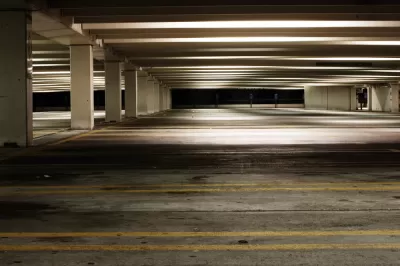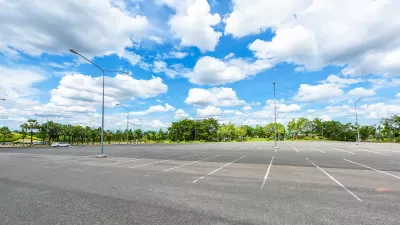In cities big and small, the tide is turning against sprawling parking lots, car-centric development, and minimum parking mandates.

American cities, designed for decades to accommodate private cars, are starting to see the benefits of reducing the amount of land used for parking and supporting other transportation modes.
According to an article by Jane Margolies in The New York Times, “The United States has about two billion parking spots, according to some estimates — nearly seven for every car. In some cities, as much as 14 percent of land area is covered with the black asphalt that engulfs malls, apartment buildings and commercial strips.” But today, as housing costs rise, housing supply fails to keep up with demand, and the negative impacts of sprawl and carbon emissions are more broadly understood, minimum parking requirements—mandates that dictate how much parking a developer must provide for a project based on the project’s use, and that often call for more parking than actually needed—are being revised or eliminated in cities and states around the country. Shifting work patterns are also reducing the need for parking in some areas, making it a good time for cities to evaluate the need for parking mandates.
Margolies outlines the history of off-street parking in the U.S., which correlates with the rise of private car ownership. “In the postwar period, when Americans were in thrall with the automobile and the federal government unfurled highways across the land, parking minimums were enshrined in zoning codes to ensure that Americans would always find a paved parallelogram waiting for them at the end of their trip.” Margolies explains that these mandates were not based on any real calculation of need, but became enshrined in the zoning codes of most cities.
Aside from promoting car ownership and inducing sprawl, parking requirements also drive up the cost of development. “Even a basic, stand-alone parking structure costs nearly $28,000 per spot on average, not including land, said Rob McConnell, a vice president at WGI, an engineering firm.” Parking reform advocates like University of California, Los Angeles (UCLA) professor Donald Shoup have spent decades arguing that parking policy has a major impact on housing and transportation costs, urban design, mobility, walkability, and quality of life.
Margolies highlights the success of the first major U.S. parking reform program in Buffalo, New York, where “A 2021 study revealed that after the repeal, new major developments overall had 21 percent fewer spaces than the minimum parking mandates would have required.” Other reforms followed at local and state levels, signaling a growing movement to reimagine how parking fits into cities.
FULL STORY: Awash in Asphalt, Cities Rethink Their Parking Needs

Planetizen Federal Action Tracker
A weekly monitor of how Trump’s orders and actions are impacting planners and planning in America.

Map: Where Senate Republicans Want to Sell Your Public Lands
For public land advocates, the Senate Republicans’ proposal to sell millions of acres of public land in the West is “the biggest fight of their careers.”

Restaurant Patios Were a Pandemic Win — Why Were They so Hard to Keep?
Social distancing requirements and changes in travel patterns prompted cities to pilot new uses for street and sidewalk space. Then it got complicated.

Platform Pilsner: Vancouver Transit Agency Releases... a Beer?
TransLink will receive a portion of every sale of the four-pack.

Toronto Weighs Cheaper Transit, Parking Hikes for Major Events
Special event rates would take effect during large festivals, sports games and concerts to ‘discourage driving, manage congestion and free up space for transit.”

Berlin to Consider Car-Free Zone Larger Than Manhattan
The area bound by the 22-mile Ringbahn would still allow 12 uses of a private automobile per year per person, and several other exemptions.
Urban Design for Planners 1: Software Tools
This six-course series explores essential urban design concepts using open source software and equips planners with the tools they need to participate fully in the urban design process.
Planning for Universal Design
Learn the tools for implementing Universal Design in planning regulations.
Heyer Gruel & Associates PA
JM Goldson LLC
Custer County Colorado
City of Camden Redevelopment Agency
City of Astoria
Transportation Research & Education Center (TREC) at Portland State University
Camden Redevelopment Agency
City of Claremont
Municipality of Princeton (NJ)





























